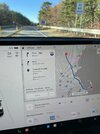Hi everyone,
First time poster.
I recently ordered a Tesla, slightly on a whim and it was delivered a week later.
Unfortunately I probably didn’t do my research. I’ve had the car a month and I have sone concerns.
I predominantly drive around town doing less than 30mph and occasionally go on dual carriage ways doing around 70mph.
I’ve just crunched the numbers and I used 65% of the battery for approx 100 miles travelled!
So doing the maths on that means 170 miles for the full charge. This seems exceptionally low. I’ve turned off sentry, don’t use air con and I’m in the Uk with temperatures ranging between 10 degrees Celsius and 20 degrees.
My usage is showing 272wh/mi for the 1000 miles I’ve had it.
I’m charging up to 85%. Last night I put it up to 100% so i could record efficiency, range etc and it only charged to 82% before stopping. It has stopped at 82% before.
I have concerns I have a serious issue with my battery as I’m charging a couple of times a week.
Would love to hear peoples thoughts. Thanks
First time poster.
I recently ordered a Tesla, slightly on a whim and it was delivered a week later.
Unfortunately I probably didn’t do my research. I’ve had the car a month and I have sone concerns.
I predominantly drive around town doing less than 30mph and occasionally go on dual carriage ways doing around 70mph.
I’ve just crunched the numbers and I used 65% of the battery for approx 100 miles travelled!
So doing the maths on that means 170 miles for the full charge. This seems exceptionally low. I’ve turned off sentry, don’t use air con and I’m in the Uk with temperatures ranging between 10 degrees Celsius and 20 degrees.
My usage is showing 272wh/mi for the 1000 miles I’ve had it.
I’m charging up to 85%. Last night I put it up to 100% so i could record efficiency, range etc and it only charged to 82% before stopping. It has stopped at 82% before.
I have concerns I have a serious issue with my battery as I’m charging a couple of times a week.
Would love to hear peoples thoughts. Thanks



